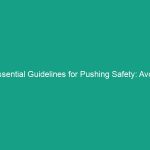Introduction
In today’s ever-evolving landscape, the significance of Health, Safety, and Environment (HSE) programs cannot be overstated, particularly for non-profit organizations. These entities, often operating with limited resources, face unique challenges that make prioritizing Safety and compliance essential. Implementing effective Safety Programs for Non-Profit Organizations not only protects employees and volunteers but also ensures that the organization can fulfill its mission without the burden of preventable accidents or legal issues. This article will delve into the critical aspects of Safety programs tailored for non-profits, covering everything from regulatory frameworks to Best Practices, real-world case studies, and practical tips for mitigating risks.
Understanding Regulatory Frameworks
Every organization, regardless of its size or sector, must navigate a complex web of Regulations governing Workplace Safety. For non-profits, this can be particularly daunting due to the variability in regulations across states and countries. Understanding the applicable laws is the first step in establishing robust safety programs.
Key Regulations Affecting Non-Profits
Among the most important regulations that non-profit organizations must adhere to are the Occupational Safety and Health Administration (OSHA) guidelines in the United States. osha sets forth Standards aimed at ensuring safe working conditions for employees. Non-profits are not exempt from these regulations; thus, understanding OSHA standards is crucial for compliance and safety.
Additionally, many states have their own safety regulations that may be more stringent than federal laws. Non-profits should conduct regular reviews of these regulations to ensure they remain compliant. Furthermore, organizations must consider sector-specific regulations, which may apply depending on their focus area, such as healthcare or education.
The Importance of Compliance
Compliance with safety regulations is not just about avoiding fines; it’s about creating a culture of safety that protects everyone involved in the organization. Non-compliance can lead to serious consequences, including accidents that could harm employees, volunteers, or the community served. Moreover, establishing a reputation as a safe organization can enhance public trust and support, which is vital for non-profit Sustainability.
Best Practices for Implementing Safety Programs
Establishing effective Safety Programs for Non-Profit Organizations requires a strategic approach. Here are some Best Practices that can help non-profits create and maintain a safe working environment.
Conducting Risk Assessments
Before implementing any safety program, organizations should carry out comprehensive risk assessments to identify potential Hazards. This involves evaluating the physical workspace, understanding the tasks performed, and considering the specific needs of employees and volunteers. Non-profits should document these assessments and use them to inform their safety protocols.
Developing Safety Policies and Procedures
Once risks are identified, it’s crucial to develop clear safety policies and procedures. These should outline protocols for various scenarios, such as emergency evacuations, reporting incidents, and using Personal Protective Equipment (PPE). Ensuring that these policies are easily accessible and understood by all staff and volunteers is essential for effective implementation.
Training and Education
Training is a cornerstone of any effective safety program. Regular Training sessions should be conducted to ensure that everyone is familiar with safety procedures and understands their role in maintaining a safe environment. This could include training on ergonomic practices, fire safety, and first aid. Engaging training methods, such as simulations and hands-on activities, can enhance understanding and retention.
Encouraging a Safety Culture
Creating a culture of safety within the organization requires commitment from leadership and active participation from all members. Leaders should model safe behaviors and continuously reinforce the importance of safety. Additionally, organizations can encourage open communication about safety concerns, allowing staff and volunteers to voice their observations and suggestions without fear of reprimand.
Case Studies: Learning from Others
Real-world examples can provide valuable insights into how non-profits successfully implement safety programs. Here, we examine a few case studies that illustrate effective practices and lessons learned.
Case Study 1: Habitat for Humanity
Habitat for Humanity, a well-known non-profit organization, emphasizes safety in all its construction activities. They have instituted a comprehensive safety program that includes mandatory training for all volunteers on construction site safety. The program has resulted in a significant reduction in accidents and has fostered a culture of safety among volunteers, ensuring that everyone understands the risks and how to mitigate them.
Case Study 2: The Red Cross
The American Red Cross has developed extensive safety programs that address both Workplace Safety and the safety of individuals receiving their services. Their training programs include disaster preparedness and response, which not only equip their staff but also empower communities. By integrating safety into their mission, they have enhanced their operational effectiveness while safeguarding their personnel and the public.
Challenges Faced by Non-Profits in Safety Implementation
Despite the clear Benefits of implementing safety programs, non-profit organizations face several challenges that can hinder their efforts. Acknowledging these challenges is the first step in overcoming them.
Limited Resources
Many non-profits operate on tight budgets, which can affect their ability to invest in safety programs. Resources may be limited for purchasing safety equipment, conducting training, or hiring external consultants for risk assessments. However, prioritizing safety does not always require significant financial investment. Organizations can often find low-cost or free resources, such as online training modules and community partnerships, to enhance their safety programs.
High Turnover Rates
Non-profits often experience high turnover rates, particularly among volunteers. This can complicate safety training efforts, as new volunteers may not receive adequate training if systems are not in place. To mitigate this, organizations should develop a streamlined onboarding process that includes safety training for all new members, ensuring that everyone is well-informed from the outset.
Lack of Awareness and Training
In some cases, staff and volunteers may not fully understand the importance of safety programs or may not prioritize them due to competing responsibilities. Regularly communicating the value of safety initiatives and integrating safety discussions into meetings can help raise awareness and keep safety top-of-mind for everyone involved.
Future Trends in Safety Programs for Non-Profits
As the landscape of Workplace Safety continues to evolve, non-profit organizations must stay informed about emerging trends and best practices in safety programs. Here are some future trends to watch.
Technology Integration
With advancements in technology, non-profits are increasingly leveraging digital tools to enhance their safety programs. This includes using mobile apps for incident reporting, virtual reality simulations for training, and data analytics to track safety performance. Embracing technology can improve efficiency and engagement in safety initiatives.
Focus on Mental Health
Recognizing the importance of mental health in the workplace is becoming a priority for many organizations, including non-profits. Programs that support mental well-being, such as stress management workshops and counseling services, can contribute to a safer and more supportive environment. Addressing mental health as part of safety programs is an emerging trend that non-profits should consider integrating.
Collaborative Safety Networks
Non-profits can benefit from forming collaborative safety networks with other organizations. By sharing resources, knowledge, and experiences, non-profits can strengthen their safety initiatives and learn from each other’s successes and challenges. These networks can facilitate joint training sessions, resource sharing, and cooperative efforts to advocate for better safety regulations.
Conclusion
Implementing effective Safety Programs for Non-Profit Organizations is not just a regulatory obligation but a moral imperative that ensures the well-being of employees, volunteers, and the communities they serve. By understanding regulatory frameworks, adopting best practices, learning from case studies, addressing challenges, and staying abreast of future trends, non-profits can create a safe working environment that allows them to focus on their mission. As non-profit leaders, it’s essential to prioritize safety and foster a culture that values health and well-being. Start today by evaluating your organization’s safety needs and taking actionable steps towards building a safer future for all.


